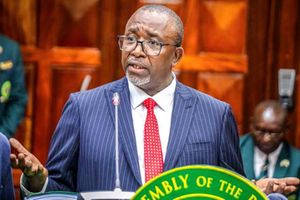Murkomen: We will build Rironi-Mau Summit highway without toll fees, debt

Trucks and other vehicles parked on the Eldoret-Nakuru highway at Mau Summit.
Fresh details have emerged on why President William Ruto put on ice plans to expand the Rironi-Mau Summit highway into a dual carriageway.
Concerns about motorists being forced to pay toll charges and the absence of alternative routes for those unwilling to pay are among reasons behind the project’s suspension.
Roads and Transport Cabinet Secretary Kipchumba Murkomen said the Sh160 billion project was too expensive “and would put an unnecessary loan burden on Kenyans”.
“My ministry is thinking of how we can construct the road without burdening Kenyans with toll fees and a Sh300 billion debt to only build 175 kilometres,” the CS said in Nakuru yesterday.
Under the plan, for every kilometre, a motorist would have had to part with Sh6. This translates to Sh1,050 for saloon cars and Sh6,300 for big trucks for the entire section. There was also another 58 kilometres that was to be refurbished and maintained as part of the 30-year project meant to open up the highway that links the capital to western Kenya and Uganda.
Mr Murkomen also revealed that the government plans to construct a bypass on the Nairobi- Nakuru highway near Nakuru City. The more than four-kilometre bypass will run from Nakuru’s Free Area to the southern side of the city near Kingdom Seekers church. There will also be a bypass from near State House Nakuru to Eveready.
President Ruto’s decision to suspend the planned expansion of the highway threw contractors and funders of the project into a spin. The move is among others that the Ruto government has made to either pause or roll back projects initiated by his predecessor.
Initiated by former President Uhuru Kenyatta, the construction of the Nairobi-Nakuru-Mau Summit toll road was initially meant to kick off in September 2021. The project was procured by the Kenya National Highway Authority (KeNHA) in 2018.
A consortium of three French firms, which won the tender, indicated it was ready to break ground on the project having received the financial backing of the African Development Bank (AfDB) and the World Bank.
The consortium, made up of Vinci Highways SAS, Meridian Infrastructure Africa Fund and Vinci Concessions SAS, was expected to recoup its investments in 30 years by charging toll fees for the use of the road.
KeNHA had finalised the issue of leeways, indicating that the contractor would use the existing ones, meaning that there would be no land acquisition for the project. At the same time, the French contractors had already done the feasibility study and shared it with KeNHA.
Proponents of the toll road argued that because it stretches across the most densely populated parts of the country, beginning with Nairobi, and traverses several counties, agricultural zones, wildlife reserves and tourism centres, its expansion would dramatically improve the country’s economic fortunes.
The highway, which is to be expanded into a six-lane dual carriageway, is the main access corridor to western Kenya and the neighbouring countries of Uganda, Rwanda and the Democratic Republic of Congo.
The highway is expected to be one of the largest public-private partnership projects in Eastern Africa. It is also expected to decongest the existing highway and thus enhance the efficiency of cargo transport to western Kenya and the other East African countries.
The Nairobi-Nakuru-Eldoret highway, which is part of the Northern Corridor, is used for transporting most of the west-bound cargo that originates from the Port of Mombasa and Nairobi.
Currently, the road carries an estimated 20,000 vehicles per day, a number that is expected to grow by 4 per cent annually.
Motorists using the highway have often blamed KeNHA for the frequent and heavy traffic jams experienced on the road. The traffic snarl-ups, sometimes stretching to almost five kilometres on both sides of the highway, are a common occurrence during the weekends and public holidays when the passenger traffic rises significantly.
The planned upgrade of the highway and the interchanges will therefore bring major relief to travellers and transporters.
Construction of the interchanges started in 2016 and were completed two years ago.
The highway has also become notorious for accidents that have so far claimed many lives along various black spots. Upgrading the road is also being seen as a way of curbing this carnage.




